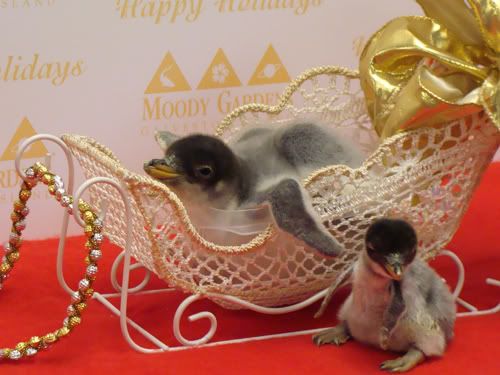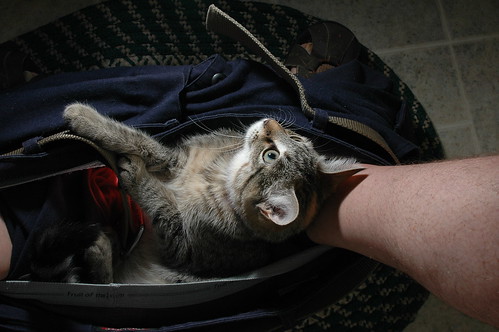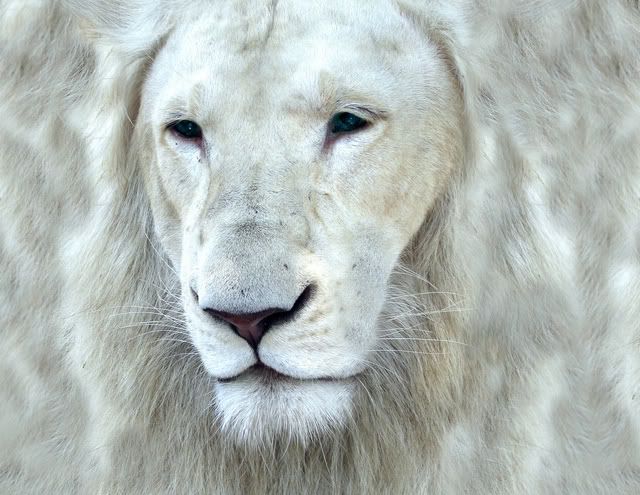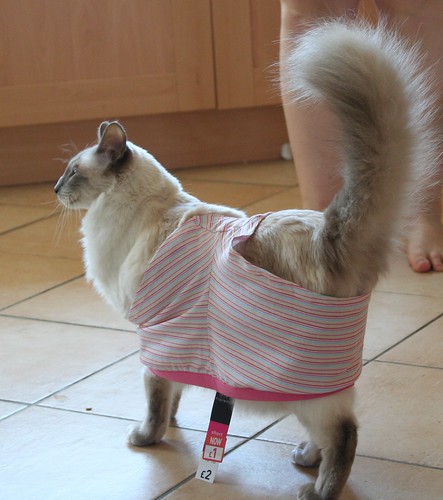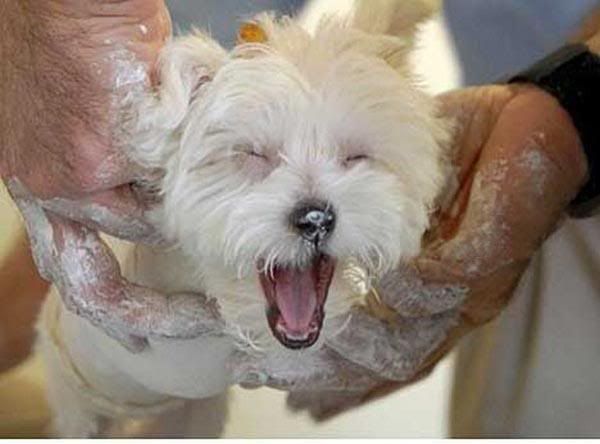Video: Starlings' spectacular show
A flight of 20,000 starlings has been performing a spectacular aerial display at a Wetland Centre in Gloucestershire.
Watch video
(via Cronaca)
Watch video
(via Cronaca)
Vote For ME!
I joined a health community which features pet health articles. You can vote for me as one of the top 100 blogs on the site. And also, check out the community. Thanks.
Classic Super Bowl Commercial - Goldfish
A classic pet related Super Bowl commercial. In this one, "Sparky" the goldfish plays dead until a boy holds a Pepsi over his tank and he performs tricks. Dad is clueless, though, and flushes the lifeless fish (a common practice).
Later, we see Sparky in the ocean doing back flips for a fisherman.
Another example of how pets help sell products.
Trackposted to Big Dog's Weblog, Cao's Blog, The Random Yak, third world county, and The Yankee Sailor, thanks to Linkfest Haven Deluxe.
Classic Super Bowl Ad - Wildlife & Car
A fun one from a tire company as a squirrel survives and his buddies are relieved.
Wildlife in the City

I'm always interested to see wildlife in the city. How do these animals adapt? Some (like the squirrels around my son's college campus) seem to thrive on pizza crusts and half eaten junk food thrown in trash cans. Others seem lost in a tiny space taken over by urban sprawl. We live in an urban neighborhood, the houses are close together and there's a fair amount of traffic on our street. But there is a bit of green space behind the house. Our tiny back yard butts up against a ravine known around town as "the hollow." A weedy, steeply sloped hole basically, too deep and swampy to develop. I am so grateful for this ravine.
Sometimes I've seen a family of deer down there. I wonder about the city deer and how their life differs from their country cousins. Do they have enough land to roam? Enough food to eat? Is their food source different? I think about the tranquil peaceful woods, and wonder if these city deer mind the noise of the city.
I've seen wild turkey down there too. Once in a while a bunny. I heard something once that sounded like a bear, but I never got any firm proof of this.
I recently read about a fascinating organization that offers an educational experience observing wildlife in NYC. Earthwatch Institute's mission is to engage people worldwide "in scientific field research and education to promote the understanding and action necessary for a sustainable environment." Cool! They offer experiences around the world. In the U.S., expeditions include studying seals in Alaska, terrapins in Pennsylvania's salt marshes, and wild horses on an island off North Carolina. The New York City expedition offers 9 days exploring the greater metropolitan area. According to the website, you will study "a range of wildlife species and the quality of their varied habitats. Depending on the time of year, you may track and camera-trap mammals, catch frogs and salamanders in nets or pitfall traps, identify birds, or survey native and invasive plant species. "
Of course, around home, I mainly see a few varieties of birds: pigeons, crows, warblers, finches. Sometimes I toss breadcrumbs outside. Who usually retrieves them? My friendly squirrel. That's okay, I love watching the squirrels. Some may disagree, but I think squirrels are the best city wildlife! They always look like they're having fun. They love to tease Kelly, taunting her from the ground and then easily darting up a tree when she runs after them.
 Paws for Reflection: Learning about wildlife in my area can help me understand how my actions affects them.
Paws for Reflection: Learning about wildlife in my area can help me understand how my actions affects them.
Classic Super Bowl Ad - Beer Fetching Dog
Two guys comparing the neat tricks their dogs can do. Not the most tasteful ad, but still a big game classic.
Why Pet Peace of Mind?
Those of us who are pet lovers understand that pets provide companionship, unconditional love, affection and acceptance. These are things we all need and crave as human beings. But imagine what it would be like to find out tomorrow that you had a terminal illness? What would happen to your pets? What if you got so ill that you couldn't take care of them anymore? What about the cost of caring for yourself and for your pets? I, for one, couldn't imagine facing the end of my life without the comforting presence of my pets. They have been with me through so many changes in my life, both good and bad. Through it all, they never criticized me or judged me for my decisions. They were just there for me. I find that many of our patients feel the same way. Their pets have been faithful and accepting when others couldn't be there, couldn't take watching them go through a long illness or the many surgeries, chemotherapy and radiation treatments. Like Mickey Rourke said in his Golden Globes' acceptance speech just last week, "Sometimes, when a man's down, that's all you've got is your dog." He knows what I'm talking about.
The Pet Peace of Mind program is about helping hospice patients give back to their faithful pet companions by providing them with the care they deserve, the care that their owners want them to have. For those of us who understand the many gifts that pets give us every day, it's a way to say thank you to our own pets by helping someone else's.
The Pet Peace of Mind program is about helping hospice patients give back to their faithful pet companions by providing them with the care they deserve, the care that their owners want them to have. For those of us who understand the many gifts that pets give us every day, it's a way to say thank you to our own pets by helping someone else's.
Labels:
giving back to pets,
Mickey Rourke
Sex pheronome will be used on vampire fish
 A synthetic "chemical sex smell" could help rid North America's Great Lakes of a devastating pest, scientists say.
A synthetic "chemical sex smell" could help rid North America's Great Lakes of a devastating pest, scientists say.US researchers deployed a laboratory version of a male sea lamprey pheromone to trick ovulating females into swimming upstream into traps.
The sea lamprey, sometimes dubbed the "vampire fish", has parasitised native species of the Great Lakes since its accidental introduction in the 1800s.
The sea lamprey's natural life cycle takes it from birth in a stream to adulthood in the ocean, where it gains its vampirical appellation.
Circular jaws lock on to another, larger fish, and a sharp tongue carves through its scales.
From then on the lamprey feeds on the blood and body fluids of its temporary host, often killing it in the process.
Eventually, the satiated lampreys - both males and females - find a suitable stream to swim up, breed and die.
Unlike salmon, which seek out the stream they were born in, lampreys appear willing to take any stream indicating a suitable breeding place; and perhaps pheromones play a role in identifying streams worth selecting.
Source: BBC
Labels:
animals,
environment,
fish
Pedigree Adoption Super Bowl Commercial
Super Bowl XLIII is going to the dogs. Well, sort of. While the top two NFL teams will battle it out on the gridiron, PEDIGREE® Food for Dogs will join the ranks of advertising elite with the airing of a new spot called “Crazy Pets.” The ad will air during the broadcast of the game on February 1, 2009 and marks the brand’s first foray into the Big Game.
The creative concept takes typical family scenarios that involve dogs and replaces them with other, unusual animals ranging from a water buffalo to a boar, to an ostrich. At its core, the ad celebrates the brand’s love of dogs and emphasizes how much better life is with a dog in it.
The airing of the spot ties into The PEDIGREE® Adoption Drive, an annual fundraising and awareness campaign the brand created five years ago as a means to shine a spotlight on the cause of dog adoption.
Crazy Pets” will air nationally following its debut during Super Bowl XLIII, and starting on January 26, 2009, can also be viewed at pedigree.com, along with behind-the-scenes vignettes featuring the “crazy pet owners” from the commercial.
WHAT DO YOU THINK OF THE COMMERCIAL? Leave your comment!
Labels:
Pet Industry,
Shelters
At Last!
Finally, after many long hours at the keyboard, the Pet Peace of Mind manual is just about finished. I have to say that I have enjoyed writing it more than just about anything I've ever done. All during my writing, I had company from all three dogs, the cat and my parrot, Quincy, who provided comic relief when I needed a break. The dogs were good company and slept most of the time, but Spike the cat kept bothering me from time to time to play fetch with him. Yes, that's correct, none of my dogs, including the retriever, fetch, but the cat fetches constantly. He brings his favorite toy of the moment to my feet and if I don't notice, he wraps himself around both ankles until I look down and see what he's up to. That's when I see the toy and the game begins. It's pretty fun, watching him run as fast as he can to the toy, belly swinging from side to side, then gently picking it up and walking back. Ok, sometimes he has to stop and play with it a while, but just when I've gone back to my typing, there he is, wrapped around my ankles. Fortunately, he gets bored quickly and needs to take a break. Otherwise, I would be working on that manual until I was retirement age!
Frog populations not helped by dinner menus
About one-third of all amphibians are listed as threatened species, with habitat loss the biggest factor.
But hunting is acknowledged as another important driver for some species, along with climate change, pollution and disease - notably the fungal condition chytridiomycosis which has brought rapid extinctions to some amphibians.
"Frogs legs are on the menu at school cafeterias in Europe, market stalls and dinner tables across Asia to high end restaurants throughout the world," said Corey Bradshaw from Adelaide University in Australia.
"Amphibians are already the most threatened animal group yet assessed because of disease, habitat loss and climate change - man's massive appetite for their legs is not helping."
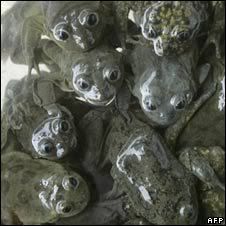 Frogs are liquidised to make a "health drink" in parts of South America.
Frogs are liquidised to make a "health drink" in parts of South America.
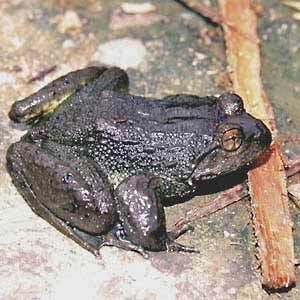 Frogs of the stream-dwelling Paa genus are among the most popular for hunting in China. But numbers in some areas have fallen 10-fold as a result of over-exploitation.
Frogs of the stream-dwelling Paa genus are among the most popular for hunting in China. But numbers in some areas have fallen 10-fold as a result of over-exploitation.
These frogs could be candidates for sustainable harvesting plans, where hunting is allowed but controlled. Image: Kadoorie Farm & Botanic Garden – KFBG
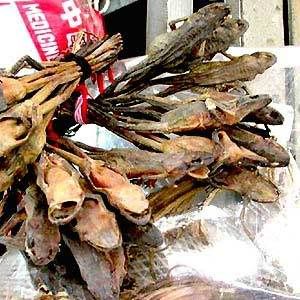 Rana chensinensis is declining steeply in some areas; a study in Heilongjiang found that the annual catch fell by 99% between 1971 and 1986. The main reason is traditional medicine.
Rana chensinensis is declining steeply in some areas; a study in Heilongjiang found that the annual catch fell by 99% between 1971 and 1986. The main reason is traditional medicine.
Oil made from the female frog's oviduct is believed to be a tonic to the kidneys and lungs, and to cure respiratory ailments. Image: KFBG
 Frogs and toads are also sold as tonics in the markets of Peru.
Frogs and toads are also sold as tonics in the markets of Peru.
This stallholder in Cuzco sells "Extracto de Rana", a drink made from the extract of two to three frogs, which is blended with honey, malt and other ingredients.
Other recipes call for 30 frogs in a single drink. Image: Esteban Lavilla
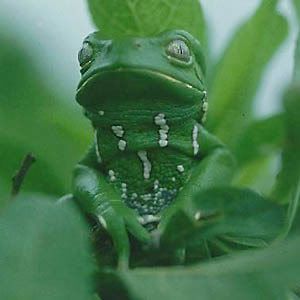 In western Brazil and eastern Peru, frogs of the Phyllomedusa genus are used as a hallucinogen.
In western Brazil and eastern Peru, frogs of the Phyllomedusa genus are used as a hallucinogen.
Chemicals secreted by the frog's skin and introduced into a human's bloodstream are said to lead initially to vomiting and incontinence, then deep sleep, and finally a period of enhanced sensitivity in sight and hearing. Image: E. Lavilla
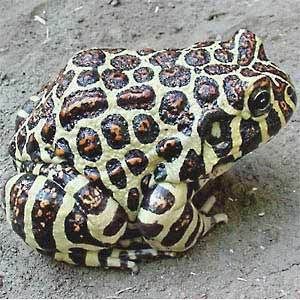 Leptodactylus laticeps is exported from South America to the developed world. It can fetch prices of 600 euros in European pet shops.
Leptodactylus laticeps is exported from South America to the developed world. It can fetch prices of 600 euros in European pet shops.
In some areas where it lives, in Argentina, Bolivia and Paraguay, people earn as little as 1,200 euros in a single year, giving them a real incentive to catch and sell it. Image: E. Lavilla
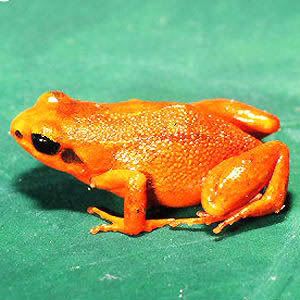 Mantellas are among the most popular frogs as pets. The principal source is Madagascar, from where many amphibians are exported into the pet trade.
Mantellas are among the most popular frogs as pets. The principal source is Madagascar, from where many amphibians are exported into the pet trade.
This species, the black-eared mantella (Mantella milotympanum), is critically endangered. Habitat loss is also a major threat. Image: Franco Andreone/ARKive
Source: BBC
But hunting is acknowledged as another important driver for some species, along with climate change, pollution and disease - notably the fungal condition chytridiomycosis which has brought rapid extinctions to some amphibians.
"Frogs legs are on the menu at school cafeterias in Europe, market stalls and dinner tables across Asia to high end restaurants throughout the world," said Corey Bradshaw from Adelaide University in Australia.
"Amphibians are already the most threatened animal group yet assessed because of disease, habitat loss and climate change - man's massive appetite for their legs is not helping."
 Frogs are liquidised to make a "health drink" in parts of South America.
Frogs are liquidised to make a "health drink" in parts of South America. Frogs of the stream-dwelling Paa genus are among the most popular for hunting in China. But numbers in some areas have fallen 10-fold as a result of over-exploitation.
Frogs of the stream-dwelling Paa genus are among the most popular for hunting in China. But numbers in some areas have fallen 10-fold as a result of over-exploitation.These frogs could be candidates for sustainable harvesting plans, where hunting is allowed but controlled. Image: Kadoorie Farm & Botanic Garden – KFBG
 Rana chensinensis is declining steeply in some areas; a study in Heilongjiang found that the annual catch fell by 99% between 1971 and 1986. The main reason is traditional medicine.
Rana chensinensis is declining steeply in some areas; a study in Heilongjiang found that the annual catch fell by 99% between 1971 and 1986. The main reason is traditional medicine.Oil made from the female frog's oviduct is believed to be a tonic to the kidneys and lungs, and to cure respiratory ailments. Image: KFBG
 Frogs and toads are also sold as tonics in the markets of Peru.
Frogs and toads are also sold as tonics in the markets of Peru.This stallholder in Cuzco sells "Extracto de Rana", a drink made from the extract of two to three frogs, which is blended with honey, malt and other ingredients.
Other recipes call for 30 frogs in a single drink. Image: Esteban Lavilla
 In western Brazil and eastern Peru, frogs of the Phyllomedusa genus are used as a hallucinogen.
In western Brazil and eastern Peru, frogs of the Phyllomedusa genus are used as a hallucinogen.Chemicals secreted by the frog's skin and introduced into a human's bloodstream are said to lead initially to vomiting and incontinence, then deep sleep, and finally a period of enhanced sensitivity in sight and hearing. Image: E. Lavilla
 Leptodactylus laticeps is exported from South America to the developed world. It can fetch prices of 600 euros in European pet shops.
Leptodactylus laticeps is exported from South America to the developed world. It can fetch prices of 600 euros in European pet shops.In some areas where it lives, in Argentina, Bolivia and Paraguay, people earn as little as 1,200 euros in a single year, giving them a real incentive to catch and sell it. Image: E. Lavilla
 Mantellas are among the most popular frogs as pets. The principal source is Madagascar, from where many amphibians are exported into the pet trade.
Mantellas are among the most popular frogs as pets. The principal source is Madagascar, from where many amphibians are exported into the pet trade.This species, the black-eared mantella (Mantella milotympanum), is critically endangered. Habitat loss is also a major threat. Image: Franco Andreone/ARKive
Source: BBC
Labels:
amphibians,
animals,
food,
frogs
Cute or not? Honduran White Bat
 Photo found at The Wonderful World of Animals
Photo found at The Wonderful World of Animals
Labels:
animals,
bats,
cute or not
Top Dog Breeds - 2008
The AKC has announce the list of Top Dog Breeds for 2008.
The breeds that made the top 10 list are the same as 2007, however a couple of breeds have switched rankings on the list.
The Bulldog has jumped two notches to land at #8, and the Shih Tzu and Poodle have both dropped one notch. Last year, for the first time since 1935, the Bulldog climbed its way into the top 10 list pushing out the Miniature Schnauzer.
And, for the 18th year in a row, the Labrador Retriever is once again the most popular dog in the United States.
The breeds that made the top 10 list are the same as 2007, however a couple of breeds have switched rankings on the list.
The Bulldog has jumped two notches to land at #8, and the Shih Tzu and Poodle have both dropped one notch. Last year, for the first time since 1935, the Bulldog climbed its way into the top 10 list pushing out the Miniature Schnauzer.
And, for the 18th year in a row, the Labrador Retriever is once again the most popular dog in the United States.
Labels:
Pet Industry
Look, a necktie for your dog
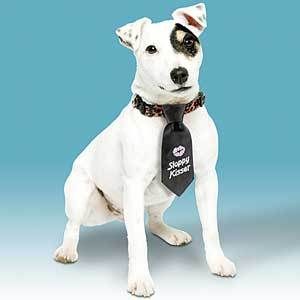 Your pet will look irresistible wearing this charming accessory, let others know that if they get too close, prepare to get a little wet! Elastic loop fits your pet comfortably. Embroidered, machine-washable polyester, 6 x 2".
Your pet will look irresistible wearing this charming accessory, let others know that if they get too close, prepare to get a little wet! Elastic loop fits your pet comfortably. Embroidered, machine-washable polyester, 6 x 2".$7.98 at Taylor Gifts
Labels:
animals,
dogs,
merchandise
Puppy Bowl V Offers Alternatives for Non-Football Fans
If watching the Superbowl isn't your thing, there's an alternative: Animal Planet's 5th Annual Puppy Bowl. The unique show will air at 3 p.m. EST, Sunday, Feb. 1, on Animal Planet. While the Arizona Cardinals and the Pittsburgh Steelers go helmet-to-helmet at Superbowl XLIII, "Pepper the Parrot" will kick-off the Puppy Bowl with a unique rendition of the national anthem. Then twenty puppies listed on Petfinder.com will fumble and tumble on their own gridiron. Halftime will feature the cat capers of the Kitty Entertainers.
The focus of Puppy Bowl is pet adoption, and viewers can logon to Petfinder.com, the first and largest online, searchable database of adoptable pets, to learn about adopting or fostering a pet in their community.
The Web site lists about 200,000 pets on any given day at over 12,500 animal placement organizations in the U.S., Canada and Mexico. It has facilitated over 13 million adoptions since it launched.
The focus of Puppy Bowl is pet adoption, and viewers can logon to Petfinder.com, the first and largest online, searchable database of adoptable pets, to learn about adopting or fostering a pet in their community.
The Web site lists about 200,000 pets on any given day at over 12,500 animal placement organizations in the U.S., Canada and Mexico. It has facilitated over 13 million adoptions since it launched.
Top Dog: Hudson
 I often write about our Yellow Lab, Hudson. Here he is when he was a puppy. He was such a sleepy, mellow pup for about the first three weeks we got him. Then--look out!
I often write about our Yellow Lab, Hudson. Here he is when he was a puppy. He was such a sleepy, mellow pup for about the first three weeks we got him. Then--look out!Why we chose a Lab: We researched breeds and thought a lab would fit our family. Labs are known to be active, good with children and devoted. Somehow, we also got an image of a calm, gentle lab stretched out in front of the fireplace. That was never Hudson's personality. Plus, we don't have a fireplace.
Hudson's favorite toy: The Daily Growl--a plastic squeaky rolled up newspaper.
Favorite activity: Swimming. Whenever we took him to the lake, he could barely wait to get out in the water. He didn't mind icy cold water, and was a strong swimmer. Even though he adored being out in the water, he always turned around and swam back the instant we called him. For a retriever, he never seemed to bother about the ducks that shared the lake.
Food treat: Pizza crust
Trick: Uh....I guess you could call this a trick. When I said "Get your toy!" he would run to the toy box and grab something to play with. That's all I've got.
Why we loved him: He always rested his head on my husband's feet. If my husband wasn't home, he'd sleep on his shoes. He was sooooo devoted and when he got sick, he was so brave. He endured pain stoically. Hudson was a wonderful member of our family for 12 years.
 Paws for Reflection: Some little puppy may grow up to be that one special Top Dog in your life.
Paws for Reflection: Some little puppy may grow up to be that one special Top Dog in your life.
Thought of the Day
"Ever consider what our dogs must think of us? I mean, here we come back from a grocery store with the most amazing haul- chicken, pork, half a cow. They must think we're the greatest hunters on earth!" - Unknown
How old is that in dog years?
This puppy was photographed in 1845, which would make it 164 years old.
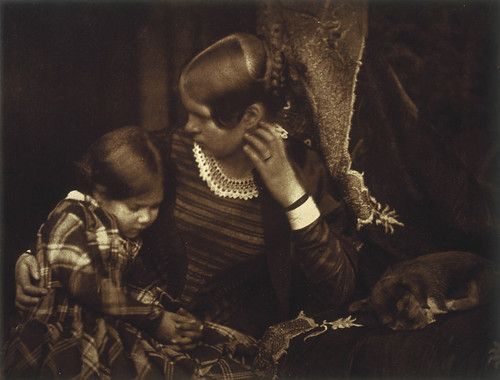 The photo, "Harriet Farnie and Miss Farnie with a Sleeping Puppy, Brownie" is from the National Galleries of Scotland's photostream, now available on Flickr.
The photo, "Harriet Farnie and Miss Farnie with a Sleeping Puppy, Brownie" is from the National Galleries of Scotland's photostream, now available on Flickr.
Robert Adamson, David Octavius Hill
1920 (original negative around 1845)
Accession no. PGP HA 390
Medium Carbon print
Size 15.40 x 20.20 cm
Credit Elliot Collection, bequeathed 1950
 The photo, "Harriet Farnie and Miss Farnie with a Sleeping Puppy, Brownie" is from the National Galleries of Scotland's photostream, now available on Flickr.
The photo, "Harriet Farnie and Miss Farnie with a Sleeping Puppy, Brownie" is from the National Galleries of Scotland's photostream, now available on Flickr.Robert Adamson, David Octavius Hill
1920 (original negative around 1845)
Accession no. PGP HA 390
Medium Carbon print
Size 15.40 x 20.20 cm
Credit Elliot Collection, bequeathed 1950
Labels:
animals,
dog,
history,
photography,
puppy
Ouch!
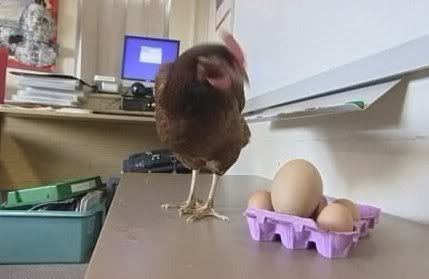 A chicken adopted by schoolchildren stunned the class by producing giant eggs nearly twice the normal size.
A chicken adopted by schoolchildren stunned the class by producing giant eggs nearly twice the normal size.Little Lil, being cared for by pupils the Raikes Centre, in Kingsholm, Gloucester, lays eggs measuring 4.3in (11cm) rather than the usual 2.4in (6cm).
Teacher Kate Farminer said pupils were astonished when the Columbian blacktail cross began producing "supersized" eggs weighing 7oz (200 grams). The average egg is around 2oz (60 grams).
Source: BBC
Science finds 3 types of fish are really 1

In an article posted on yahoo news, Researchers believe they have solved the puzzle of three seemingly different fish, one all males, one all females and one all juveniles. They're the same fish, and undergo remarkable changes as they mature.
"You can imagine it was a pretty exciting discovery," said G. David Johnson, an ichthyologist at the Smithsonian's National Museum of Natural History. "The pieces kept falling into place."
"And it tells you how little we know about the deep sea, Johnson said in a telephone interview.
The fish live in the sparsely populated deep water thousands of feet below the surface, though as youngsters they rise to shallower levels where there is more to eat.
Cetomimidae, a type of whalefish, had been known since the 19th century, but only females had been found.
Seemingly related species called Mirapinnidae, or tapetails, and Megalomycteridae, or bignose fish, were identified in the 1950s and 1960s. Tapetails were only found as juveniles and bignoses only as males.
Although their skeletons indicated the three were related, there were so many differences no one could believe they were the same fish at different sexes or stages in life, Johnson said.
But it turns out that is the case, Johnson and colleagues report this week in Biology Letters, a journal of Britain's Royal Society.
All three will now be classified as Cetomimidae, he said.
Johnson said the researchers were able to link the fish through comparative anatomical study and, once they obtained fresh samples, by their DNA.
The larvae are called tapetails because they grow long streamers, he said. The purpose of the streamer remains unknown, but several fish larvae develop similar appendages, so it must have some value, he said. They reside within 600 feet of the surface, a region well stocked with food.
As adults, however, these fish descend thousands of feet down into the dark ocean.
There is scarce food there and the females cope by developing a large mouth — a common trait among fish living in the deepest waters — and they even develop teeth in their gill area that can serve as an additional mouth.
Even stranger, males who reach adulthood don't eat at all. Having gorged as larvae, their jaw fuses and they develop a vestigial gut that only stores shells from previous meals. That's an advantage, Johnson said, because in the deep ocean "there's not a lot of food, you're better off taking your lunch with you." The males gorge as larvae and grow a giant liver, storing energy there to live on.
"This thing was basically a set of testes looking for the female," Johnson said.
The males also develop a large nose to sense smells in the dark water.
Meanwhile, researchers had noted that females have some unusual tissue, separate from the skin, on their body. It's not luminous, so Johnson speculated that this tissue may produce a pheromone that the big-nosed male can home in on.
Co-authors of the paper were John R. Paxton of the Australian Museum, Sydney; Tracey T. Sutton of the Virginia Institute of Marine Science, Takashi P. Satoh and Mutsumi Nishida of the University of Tokyo and Tetsuya Sado and Masaki Miya of the Natural History Museum, Chiba, Japan.
Labels:
Current News
That Big Word: Verisimilitude
 When writing personal experience stories, or ghostwriting someone else's story, the question of truthfulness frequently crops up. Composite characters, creative license, stretching details to make a point; it's all prickly. No reputable writer will deny that truthfulness and accuracy is utmost on their mind. We all remember James Frey. Yet we've also been taught about verisimilitude and the idea of telling a true story in a writerly fashion to best convey emotion and meaning. If we want readers, our work must be compelling. Some may wonder where to draw the line. And when you're reading, how can you know what to trust?
When writing personal experience stories, or ghostwriting someone else's story, the question of truthfulness frequently crops up. Composite characters, creative license, stretching details to make a point; it's all prickly. No reputable writer will deny that truthfulness and accuracy is utmost on their mind. We all remember James Frey. Yet we've also been taught about verisimilitude and the idea of telling a true story in a writerly fashion to best convey emotion and meaning. If we want readers, our work must be compelling. Some may wonder where to draw the line. And when you're reading, how can you know what to trust?(Although referring to the movie and not the book) I found John Grogan's recent blog entry regarding the movie Marley & Me, quite interesting:
John Grogan's Blog: "The movie is not quite my book and not quite our real lives, and I think moviegoers, at least those who have also read or will read my books, understand that. It's a fictionalized movie inspired by my book, not a documentary. The director and screenwriters took liberties, invented characters and scenes and fudged some facts to make the story work for screen. I'm fine with that, especially because I have my books as a public record of the real story."
He adds that movie director David Frankel did a wonderful job that "captures the emotional truths of my family's experience."
I agree, in a movie, we might come to expect that the events are "based on fact." I recently read an article on the movie "Twenty-one" and the far-from-fact portrayal of many of the details and people in that movie. In non-fiction books, however, I think the reader is expecting more than just the essence of the truth. It's not always easy to convey the facts in the most interesting fashion when you have to stick to the truth. More than once I've interviewed a narrator, hoping for a certain answer that would fit perfectly in the story I'm writing. And when the narrator's answer is not what I hope for, it's disappointing. The trick is to craft something interesting and exciting around that true answer. When we've succeeded at that, the outcome is an article we can feel confident is both factual and entertaining.
 Paws for Reflection: I'll just say that, although I write mainly non-fiction, this is one reason I enjoy writing fiction pieces, too!
Paws for Reflection: I'll just say that, although I write mainly non-fiction, this is one reason I enjoy writing fiction pieces, too!P.S. Speaking of Marley and Me, I also enjoyed reading that Cesar Milan from National Geographic Channel's The Dog Whisperer has been working with Grogan and his family, and their new labs Gracie and Woodson. Yay!
Way too cute!
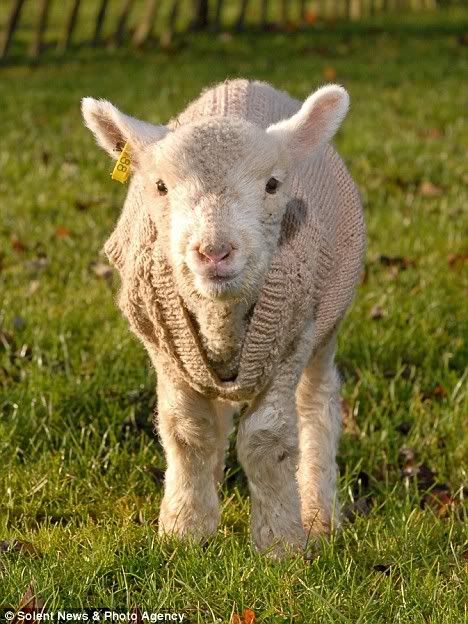 This tiny, orphaned lamb, who is one of twins, was rescued by volunteers at Manor Farm Country Park, near Southampton, Hampshire. Concerned about the risk of the tiny new born perishing in the cold weather, volunteers at the farm found him a knitted baby sweater to keep him warm.
This tiny, orphaned lamb, who is one of twins, was rescued by volunteers at Manor Farm Country Park, near Southampton, Hampshire. Concerned about the risk of the tiny new born perishing in the cold weather, volunteers at the farm found him a knitted baby sweater to keep him warm.Source: Daily Mail
Labels:
animals,
cute,
lambs,
white animals
Frankie, the Walk 'N Roll Dog
 The story of Frankie, the Walk ‘N Roll Dog is a true, inspirational story about a dog whose life started out just like any other dog walking on all four paws until a spinal injury leaves her paralyzed. When Frankie is custom fit for a wheelchair she gradually learns to keep on rolling. Her zest for life will have you cheering her on and give you hope that all things are possible.
The story of Frankie, the Walk ‘N Roll Dog is a true, inspirational story about a dog whose life started out just like any other dog walking on all four paws until a spinal injury leaves her paralyzed. When Frankie is custom fit for a wheelchair she gradually learns to keep on rolling. Her zest for life will have you cheering her on and give you hope that all things are possible.On Frankie's website, there are more photos of Frankie and some insights into what her life is like.
Rabbid Rabbits?

Don't they look yummy?
Found at Anna the Red's Bento Factory, where you can also find instructions for sushi and creative bento ideas.
Winter Blues for Dogs
When the holidays are over, many adults tend to get the so-called winter blues. Affected people may have bouts of unexplained crying, desire for sweets, excessive fatigue, lethargy, depression, anxiety, and mood swings. But can dogs also feel the blues?
According to an article The Pet Place, dogs likely aren't feeling the same symptoms, but more likely, your dog is mirroring your own feelings.
For instance, some of the search and rescue dogs at the World Trade Center site got depressed because they picked up on the feelings of their human handlers, who were faced with a tragedy of unimaginable proportions.
The dogs were also at risk for depression because they were eager to succeed. They were trained to find survivors, and failure to do so was upsetting. To combat the sense of failure, human handlers "hid" so the dogs could "find" them. This boosted the dogs' confidence and self-esteem.
Dogs do have a hormonal response to the change in seasons. For instance, they shed their coats in spring and fall. But Dodman says it's a stretch to say that dogs experience the winter blues themselves.
Dogs do seem to be prone to cabin fever, like people. And even worse for them, they are not as entertained as us by watching old reruns or rented movies. But they do like exercise, which is the best tonic for winter blues for people and pets.
According to an article The Pet Place, dogs likely aren't feeling the same symptoms, but more likely, your dog is mirroring your own feelings.
For instance, some of the search and rescue dogs at the World Trade Center site got depressed because they picked up on the feelings of their human handlers, who were faced with a tragedy of unimaginable proportions.
The dogs were also at risk for depression because they were eager to succeed. They were trained to find survivors, and failure to do so was upsetting. To combat the sense of failure, human handlers "hid" so the dogs could "find" them. This boosted the dogs' confidence and self-esteem.
Dogs do have a hormonal response to the change in seasons. For instance, they shed their coats in spring and fall. But Dodman says it's a stretch to say that dogs experience the winter blues themselves.
Dogs do seem to be prone to cabin fever, like people. And even worse for them, they are not as entertained as us by watching old reruns or rented movies. But they do like exercise, which is the best tonic for winter blues for people and pets.
Time to appreciate penguins
January 20 is Penguin Awareness Day.
Why is today Penguin Awareness day? No one knows.
What's so special about this day? No one knows.
So - celebrate in your own way ...
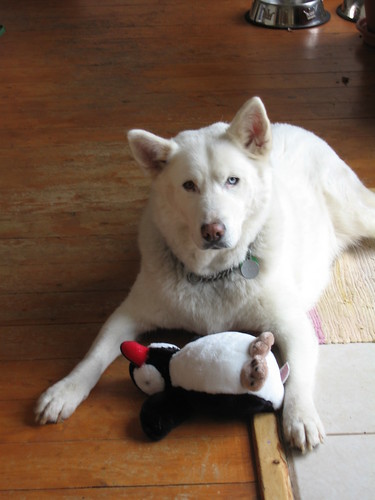 from Flickr, by ekpatterson
from Flickr, by ekpatterson
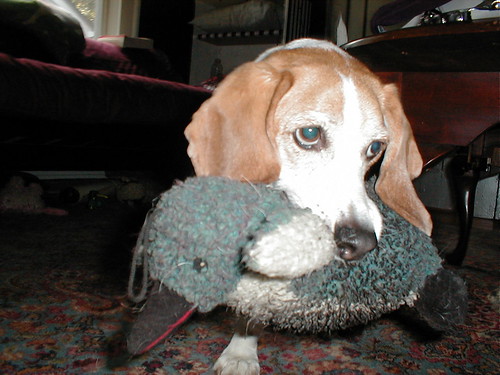 from Flickr, by moria
from Flickr, by moria
 from Flickr, by rarewren
from Flickr, by rarewren
(via Penguins!)
Why is today Penguin Awareness day? No one knows.
What's so special about this day? No one knows.
So - celebrate in your own way ...
 from Flickr, by ekpatterson
from Flickr, by ekpatterson from Flickr, by moria
from Flickr, by moria from Flickr, by rarewren
from Flickr, by rarewren(via Penguins!)
When Barks Turn to Brrrrs, It’s Winter
North Shore Animal League America Experts Offer Winter Tips for Your Pets
– Winter can be a marvelous time of year, especially for pets who love the outdoors. However, we must not forget the hazards that this season brings for our best friends. The pet experts at North Shore Animal League America , the world’s largest no-kill animal rescue and adoption organization, urge pet owners to be mindful of the time their pets spend in the frigid outdoors.
Here are some tips to help keep your pets safe and comfortable:
1. Antifreeze and rock salt are poisonous to your pets. Make sure to keep these and other harmful chemicals out of your pet’s reach or path. For an extra measure of safety, ask your retailer about eco-and-pet-friendly products.
2. Feral and stray cats often take winter refuge under cars and can sometimes even make their way under the hood. Make sure the coast is clear before starting your car.
3. Be sure to wipe your dog’s feet (and stomach, with small dogs) after a winter walk. Rock salt or other ice melting chemicals can cling to your pet’s fur and he can ingest these poisonous chemicals when cleaning himself.
4. ALL PETS NEED TO BE INSIDE. Never leave your pet outside for extended periods of time, even in a doghouse. When the temperature drops, your pet can freeze to death. If you notice a pet being locked outside in the winter, be sure to report it to your local animal control facility.
5. Keep an eye on your pet’s water dish to ensure it did not freeze.
6. Short-coated dogs are especially vulnerable to the cold and shouldn’t be outside unattended for too long a time span.
7. Most people know not to leave their pets in a car in the summer, but the same goes for the winter. A car interior can get as cold as an ice box and a pet can easily freeze.
8. Check your dog’s paw pads for ice balls. If your dog is lifting his feet a lot or seems to be walking strangely, his feet are probably too cold or ice may be forming which can cause frostbite.
9. Keep your pet groomed. Knotted or matted hair doesn’t insulate properly. Brush your dog’s hair regularly in the wintertime especially.
10. Adjust your pet’s diet as necessary. If your dog spends a lot of time outside, he may need more calories in the winter to produce body heat. If your dog spends most of his time indoors and has a decrease in activity, he may require fewer calories. When in doubt, always ask your vet about seasonal diet changes.
For more information on the North Shore Animal League, visit www.AnimalLeague.org
– Winter can be a marvelous time of year, especially for pets who love the outdoors. However, we must not forget the hazards that this season brings for our best friends. The pet experts at North Shore Animal League America , the world’s largest no-kill animal rescue and adoption organization, urge pet owners to be mindful of the time their pets spend in the frigid outdoors.
Here are some tips to help keep your pets safe and comfortable:
1. Antifreeze and rock salt are poisonous to your pets. Make sure to keep these and other harmful chemicals out of your pet’s reach or path. For an extra measure of safety, ask your retailer about eco-and-pet-friendly products.
2. Feral and stray cats often take winter refuge under cars and can sometimes even make their way under the hood. Make sure the coast is clear before starting your car.
3. Be sure to wipe your dog’s feet (and stomach, with small dogs) after a winter walk. Rock salt or other ice melting chemicals can cling to your pet’s fur and he can ingest these poisonous chemicals when cleaning himself.
4. ALL PETS NEED TO BE INSIDE. Never leave your pet outside for extended periods of time, even in a doghouse. When the temperature drops, your pet can freeze to death. If you notice a pet being locked outside in the winter, be sure to report it to your local animal control facility.
5. Keep an eye on your pet’s water dish to ensure it did not freeze.
6. Short-coated dogs are especially vulnerable to the cold and shouldn’t be outside unattended for too long a time span.
7. Most people know not to leave their pets in a car in the summer, but the same goes for the winter. A car interior can get as cold as an ice box and a pet can easily freeze.
8. Check your dog’s paw pads for ice balls. If your dog is lifting his feet a lot or seems to be walking strangely, his feet are probably too cold or ice may be forming which can cause frostbite.
9. Keep your pet groomed. Knotted or matted hair doesn’t insulate properly. Brush your dog’s hair regularly in the wintertime especially.
10. Adjust your pet’s diet as necessary. If your dog spends a lot of time outside, he may need more calories in the winter to produce body heat. If your dog spends most of his time indoors and has a decrease in activity, he may require fewer calories. When in doubt, always ask your vet about seasonal diet changes.
For more information on the North Shore Animal League, visit www.AnimalLeague.org
Working furiously on a big project!
I've been writing like crazy, working on a big project concerning the Pet Peace of Mind program. I can't divulge the details yet, but we have a wonderful opportunity to take the program beyond our hospice. So, that means long hours holed up in a quiet place to put the program's inner workings down on paper. I hope to share some of the stories of our patients and their pets as soon as I get this finished. The deadline is next Friday, so I have to get three more chapters done before then.
One of my own dogs made me laugh out loud this morning. I have a small blue heeler named Tsisdu (pronounced Chisdu, it means "rabbit" in Cherokee). She is a live wire, as far as dogs go. We call her Tsisdu because her feet never touch the ground. Anyway, my husband has been working in the garage and he moved her crate. This morning, she ran down the stairs into the garage to get into her crate and saw the empty space. At first, she was bewildered and then she got angry. Someone had moved her house! I had to get her calmed down enough (she was whirling in a circle and barking) to look behind her and see it. Then, all was well. Never a dull moment at our house.
One of my own dogs made me laugh out loud this morning. I have a small blue heeler named Tsisdu (pronounced Chisdu, it means "rabbit" in Cherokee). She is a live wire, as far as dogs go. We call her Tsisdu because her feet never touch the ground. Anyway, my husband has been working in the garage and he moved her crate. This morning, she ran down the stairs into the garage to get into her crate and saw the empty space. At first, she was bewildered and then she got angry. Someone had moved her house! I had to get her calmed down enough (she was whirling in a circle and barking) to look behind her and see it. Then, all was well. Never a dull moment at our house.
Looking back - origin of the 'Poodle Cut'
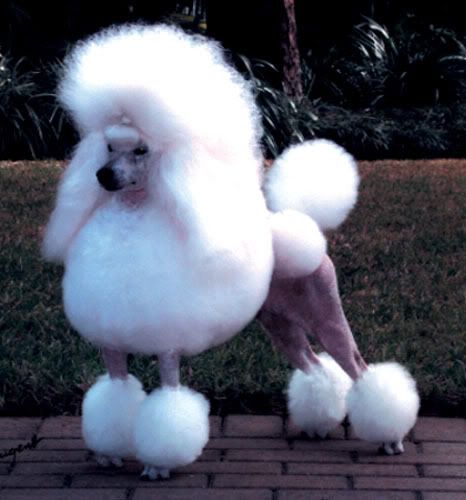
Jan at the Poodle (and Dog) Blog posted a great explanation about the origin of the canine hairstyle known as the "poodle cut."
Here's Jan's theory ...
Cabin Fever

In Vermont, we used to talk about Cabin Fever this time of year. It was a time when we got so snowbound and stuck in the house for so long, we were nearly crazy from isolation. I don't hear the phrase used much here in New York. However, I know I'm sick of the snow and cold weather.
Here are some ways to get through the dreaded cabin fever:
1. Embrace the outdoors! Take up a sport like snowshoeing or cross country skiing. If you can't beat the weather, join it! If your dog's a cold weather breed, don't forget to take him along.
2. Organize a game night. Invite a few friends over, sit by the fireplace (if you have one. We don't, and I always wanted one.) and get ready for the night to whizz by! Some of our favorites are Scattergories, Catch Phrase, Dominoes, and Canasta. What games do you enjoy?
3. Curl up with a great book. 'Nuff said.
4. Bring in some pretty blooms, like the flowers pictures above. Nothing will get your thoughts turning to spring faster than a fresh bouquet. Pick bright, cheerful colors and breath in that wonderful scent.
How do you get through the winter doldrums?

Paws for Reflection: Love the season you're in.
Cute or not? Giant Frog Fish
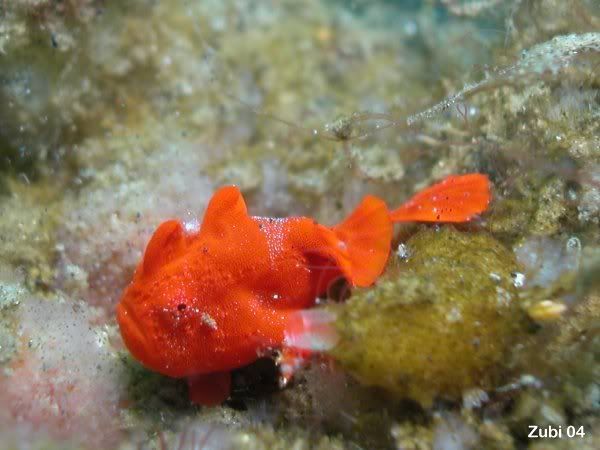 This photo of a Giant frogfish - Antennarius commerson (commersonii) is from the Frog Fish website by Teresa Zubi
This photo of a Giant frogfish - Antennarius commerson (commersonii) is from the Frog Fish website by Teresa Zubi
Labels:
animals,
cute or not,
fish
Hallmark Contest
Hallmark is in search of real pictures of real bloopers -- that could become real greeting cards. Hallmark is holding an open call for consumers’ funniest photos, along with a corresponding “birthday” greeting. The photo and greeting will be judged and turned into actual Hallmark cards.
How it works: Just log on to hallmarkcontests.com anytime before Feb. 1 and upload your photo and birthday greeting.
Winning Big: Sixty finalists' cards will be printed and sold to the public (both at hallmark.com and in stores). They also will win $250 cash and become part of a secret humor card review panel. In addition, one grand prize winner will win $2,500 and their card will become part of Hallmark's regular humor line!
You can log on to vote for the winner at hallmarkcontests.com starting March 9, when the finalists will be posted.
---The Pet Haven is not associated with the contest ---
How it works: Just log on to hallmarkcontests.com anytime before Feb. 1 and upload your photo and birthday greeting.
Winning Big: Sixty finalists' cards will be printed and sold to the public (both at hallmark.com and in stores). They also will win $250 cash and become part of a secret humor card review panel. In addition, one grand prize winner will win $2,500 and their card will become part of Hallmark's regular humor line!
You can log on to vote for the winner at hallmarkcontests.com starting March 9, when the finalists will be posted.
---The Pet Haven is not associated with the contest ---
"Retro" Pet Fountain

Petmate's radically 'retro' stainless steel Fresh Flow Pet Fountain is trying to make fashion waves. These refillable waterers (if that's even a word) promote health by encouraging pets to drink more. The purifying pet fountain is ideal for homes with multiple pets.
I haven't tried it out, but if you have one, I'd love to hear your thoughts.
Labels:
Pet Industry,
Product Review
Anamigo online pet community
 I found this cute picture at Anamigo.com which is an online community where you can find everything about pets and the people that love them. Aside from the tips and advice on pet care and the latest accessories, you will find adorable photos of member's pets.
I found this cute picture at Anamigo.com which is an online community where you can find everything about pets and the people that love them. Aside from the tips and advice on pet care and the latest accessories, you will find adorable photos of member's pets.Anamigo is holding a Pet Photo Contest
Is your pet cute enough to win you $300?
Enter the Anamigo Pet Photo contest and find out.
Entries that get the most votes will win daily and weekly cash prizes.
You could win:
- Daily prize of $25. (You have 7 days to win!)
- Weekly prize of $125
Get your camera out and email your friends. Your furry friend could bring you in cash!
Subscribe to:
Posts (Atom)






